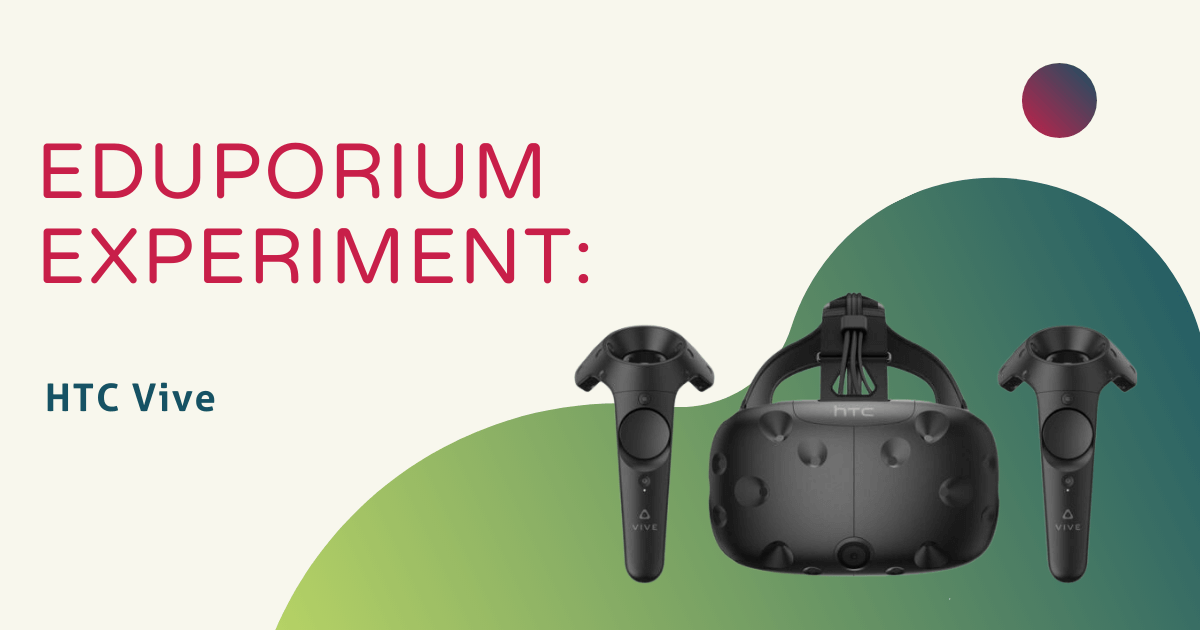Have you ever wanted to go somewhere you couldn’t? Like the Great Wall of China, or the stomach of a whale, or any other place not suitable for a school field trip? Well, now students can experience lifelike content from afar with virtual reality! VR is making its way into the educational sphere, empowering students to explore previously unreachable destinations and interact directly with virtual objects. A few weeks ago, I experimented with the Oculus Rift virtual reality system, and this time I got to try out the HTC Vive—just another perk of working at Eduporium!
Our resident VR expert, Khat, started by giving me a quick tutorial. He explained how the headset was recently updated to include headphones and a hard harness outfitted with a tightening screw for adjustment. I found the headset to be a bit heavy, but this is the case for most VR headsets—especially the most powerful ones. I also noticed the faceplate was larger than that of the Oculus, and that the wireless controllers were also larger. They were less like video game controllers, which the Oculus controllers more closely resembled.
The set-up for the Vive is a bit complex because it requires more power, particularly for its sensors. Mounting equipment is included to place the sensors on walls on opposite sides of the room, however, this isn’t necessary and not something we took the time to do in our office. We purchased tripods to mount the sensors on because they have the flexibility to be moved and disassembled, yet they take up more space. Although the physical set-up is a bit more involved, the software set-up was simple—all I had to do was follow the on-screen prompts.
I first completed the room set-up and then the tutorial. The room set-up involved setting the height and play space boundaries. A helpful option the Vive offers is selecting whether you have room to move around or standing room only in case your space to walk around is limited. The subsequent tutorial then consisted of getting used to the controllers and pointing, selecting, and shooting. It was so cool being able to see the controllers in the VR world, so I could really see where I was aiming the whole time!
Post-tutorial, I browsed the available software that’s part of the Steam network. I clicked the Education category, and found almost 400 software choices! When I filtered it down by computer and VR system, almost 70 options remained, still giving me plenty to choose from! Some were available for free while others have a cost associated with them, and some were interactive, while others were spectator-based. I decided to try out Edmersiv, described as “the first educational lab for VR,” where users are able to “interact with several different educational objects, simulations, animations, environments, and games.”
I was able to visit Pompeii, learn how a loom works, practice mixing colors, and examine a skeleton, various cells, and more. It was science fair-esque since I was able to try out various mini-experiments and games. Although the graphics weren’t spectacular, it definitely felt like a glimpse into what VR education will be like in the near future!
We’re fairly certain that educators will soon be able to completely reimagine immersive education with technologies like the HTC Vive. To purchase one for your classroom (or yourself), click below to visit the Eduporium store! We also offer various VR bundles, including the RobotLAB VR Expeditions 2.0 kits, making it as easy as possible to get your equipment all in one place. And, look out next Wednesday for the next edition of the Eduporium Experiment featuring the 3D Simo! In the meantime, don't forget to follow us on Twitter and Instagram, for more and you might as well like us on Facebook, too!



